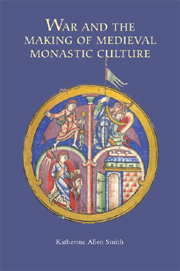Book contents
- Frontmatter
- Contents
- Dedication
- Acknowledgments
- List of Abbreviations
- Introduction
- 1 Encountering War in the Scriptures and Liturgy
- 2 Monks and Warriors: Negotiating Boundaries
- 3 Spiritual Warfare: The History of an Idea to c.1200
- 4 Martial Imagery in Monastic Texts
- 5 Warriors as Spiritual Exemplars
- Conclusion
- Appendix: The Loricati, c.1050–1250
- Bibliography
- Index
- Title in the Series
4 - Martial Imagery in Monastic Texts
Published online by Cambridge University Press: 05 February 2013
- Frontmatter
- Contents
- Dedication
- Acknowledgments
- List of Abbreviations
- Introduction
- 1 Encountering War in the Scriptures and Liturgy
- 2 Monks and Warriors: Negotiating Boundaries
- 3 Spiritual Warfare: The History of an Idea to c.1200
- 4 Martial Imagery in Monastic Texts
- 5 Warriors as Spiritual Exemplars
- Conclusion
- Appendix: The Loricati, c.1050–1250
- Bibliography
- Index
- Title in the Series
Summary
Even as the clerical creation of a new model of christian knighthood threatened the long-held monastic monopoly on spiritual warfare, monks clung tenaciously to their identification with the true milites Christi and continued to present their calling as a form of military service superior to any other. ‘do not yearn to be sent forth to the place of battle,’ the Cistercian abbot Aelred of Rievaulx (d.1166) told his monks, ‘for this is the place of battle.’ A survey of sermons, letters, and works of hagiography by monastic authors of the eleventh and twelfth centuries turns up this sort of martial rhetoric at seemingly every turn; indeed, one can hardly find an author who never used military language in reference to the religious life, and it is not unusual to encounter allegories involving monk-soldiers, demonic armies, and monastery-citadels under siege which are far more elaborate (and bloody) than anything to be found in patristic or carolingian texts. Modern scholars have often noted the presence of this material, and a handful of studies have examined the use of military imagery by individual authors or members of particular orders. With the goal of gaining a better understanding of how martial rhetoric both reflected and shaped monastic identities in the central Middle ages, this chapter casts a wider net across orders and genres, seeking to identify rhetorical patterns and to connect these, in turn, to specific contemporary practices and concerns.
- Type
- Chapter
- Information
- War and the Making of Medieval Monastic Culture , pp. 112 - 155Publisher: Boydell & BrewerPrint publication year: 2011



